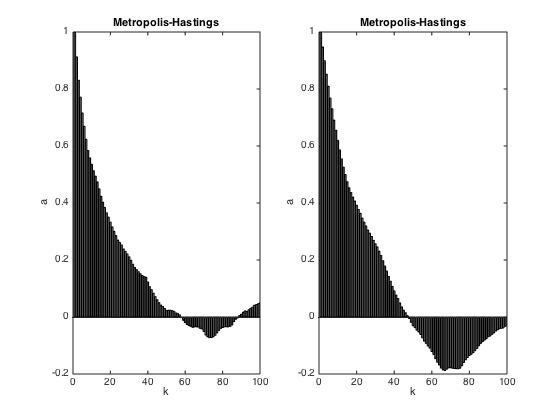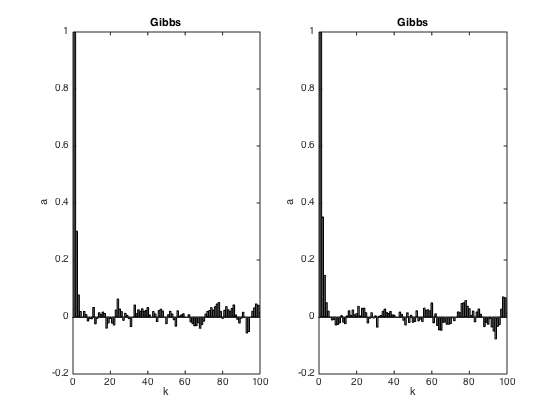Contents
convergence.m
Scripts demonstrating issues related to autocorrelation and MCMC convergence
From A First Course in Machine Learning Simon Rogers, August 2016 [simon.rogers@glasgow.ac.uk]
clear all; close all;
Create an object holding some Gaussian contours
clear all;close all; mu = [1;2]; co = [1 0.8;0.8 2]; [Xv,Yv] = meshgrid([-2:0.1:4],[-1:0.1:5]); Ci = inv(co); P = zeros(size(Xv)); for i = 1:size(Xv(:)) P(i) = - log(2*pi) - 0.5*log(det(co)) - 0.5*([Xv(i)-mu(1) Yv(i)-mu(2)]*Ci*[Xv(i)-mu(1) Yv(i)-mu(2)]'); end P = exp(P);
Do some MH samples from this Gaussian with multiple chains
figure(); hold off contour(Xv,Yv,P,'k','linewidth',2,'color',[0.6 0.6 0.6]) hold on % Vary jump_sig2 to give different levels of convergence jump_sig2 = 0.4; % Define the starting points of the chains start_points = {[-3;1],[5;1],[1.5;5]}; plot_cols = {'ko','r^','gs'}; % Generate 200 samples for each chain and plots the samples for i = 1:length(start_points) accept{i} = 0; x = start_points{i}; S = 2000; N = length(x); all_samps_mh{i} = zeros(S+1,N); all_samps_mh{i}(1,:) = x'; Ci = inv(co); old_log_like = -0.5*(x - mu)'*Ci*(x - mu); for s = 1:S new_x = x + randn(N,1).*sqrt(jump_sig2); new_log_like = -0.5*(new_x - mu)'*Ci*(new_x-mu); r = exp(new_log_like - old_log_like); if rand <= r x = new_x; old_log_like = new_log_like; accept{i} = accept{i} + 1; end all_samps_mh{i}(s+1,:) = x'; end plot(all_samps_mh{i}(:,1),all_samps_mh{i}(:,2),plot_cols{i}) accept{i} = accept{i}/S; end
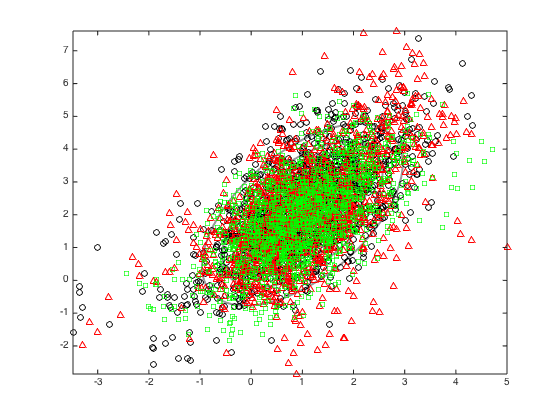
Plot a trace of the sample means at different numbers of samples
Define the samples at which the plots should be made
plot_points = [2,3,5,10,20,50,100,1000];
plot_cols = {'ko','ks','k^'};
fill_cols = {[0 0 0],[1 1 1],[0.6 0.6 0.6]};
fig_no = 1;
for var_no = 1:N
fig_no = fig_no + 1;
figure(fig_no);
hold off
cum_means{var_no} = [];
for j = 1:length(start_points)
for k = 1:length(plot_points)
cum_means{var_no}(k,j) = mean(all_samps_mh{j}(1:plot_points(k),var_no));
end
semilogx(plot_points,cum_means{var_no}(:,j),[plot_cols{j} '-'],'markerfacecolor',fill_cols{j},'markersize',10)
hold on
ylabel(sprintf('$\\mu_{\\theta_%g}$',var_no));
end
end
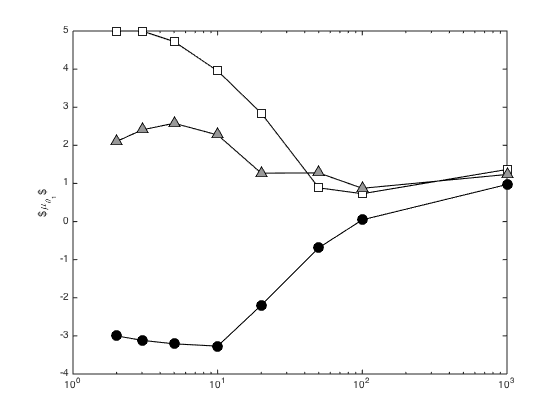
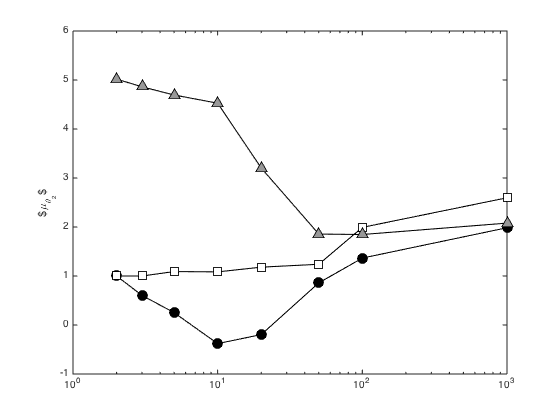
Compute and plot R_hat
close all figure();hold off plot_points = [2,3,5,10,20,50,100,1000,2000]; M = length(start_points); for par = 1:2 for i = 1:length(plot_points) N = plot_points(i); mu_m = []; v_m = []; for s = 1:length(start_points) % Compute R_hat -- see p.333 (a.k.a. The Gooch page) mu_m(s) = mean(all_samps_mh{s}(1:N,par)); v_m(s) = var(all_samps_mh{s}(1:N,par)); mu_m_mean = mean(mu_m); B =(N/(M-1))*sum((mu_m-mu_m_mean).^2); W = mean(v_m); V = ((N-1)/N)*W + (1/N)*B; R(i,par) = sqrt(V/W); end end end plot(log(plot_points),R(:,1),'k','linewidth',2) hold on plot(log(plot_points),R(:,2),'k--','linewidth',2) yl = ylim; ylim([0 yl(2)]) xlim([log(plot_points(1)) log(plot_points(end))]) xlabel('S') ylabel('R')
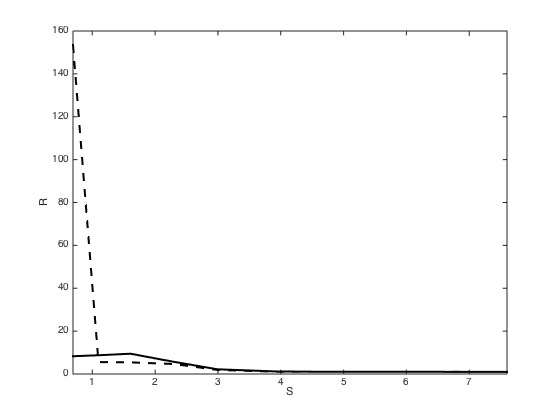
Autocorrelation
First, so some Gibbs samples for comparison
all_samps_mh{4} = zeros(2000,2);
x = start_points{1};
for i = 1:2000
% Sample x_1
mu_1 = mu(1) + (co(1,2)/co(2,2)) * (x(2)-mu(2));
ss_1 = co(1,1) - co(1,2)^2/co(2,2);
oldx = x;
x(1) = randn*sqrt(ss_1) + mu_1;
% sample x_2
mu_2 = mu(2) + (co(2,1)/co(1,1)) * (x(1)-mu(1));
ss_2 = co(2,2) - co(2,1)^2/co(1,1);
oldx = x;
x(2) = randn*sqrt(ss_2)+mu_2;
all_samps_mh{4}(i,:) = x';
end
Compute the autocorrelation of the MH and the Gibbs
k_vals = [0:1:100]; s_val = [1,4]; % Plot the AC of the first MH and Gibbs for start_val = s_val figure(start_val) ac = zeros(length(k_vals),2); for par = 1:2 temp = all_samps_mh{start_val}(:,par); temp = temp - mean(temp); N = length(temp); ss = var(temp); for k = 1:length(k_vals) ac(k,par) = sum(temp(1:end-k_vals(k)).*temp(1+k_vals(k):end)); ac(k,par) = ac(k,par)/(ss*(N-k_vals(k))); end subplot(1,2,par) bar(ac(:,par),'facecolor',[0.6 0.6 0.6]) xlim([0 100]) ylim([-0.2 1]) xlabel('k'); ylabel('a'); if start_val == 1 title('Metropolis-Hastings') else title('Gibbs') end end end
